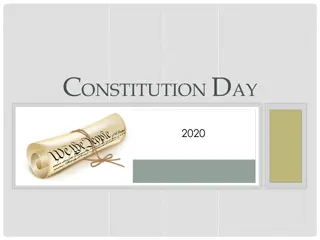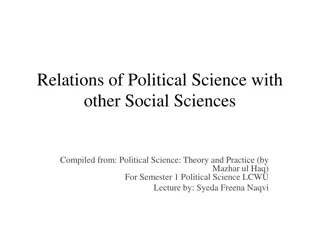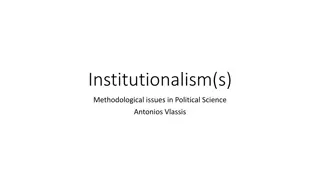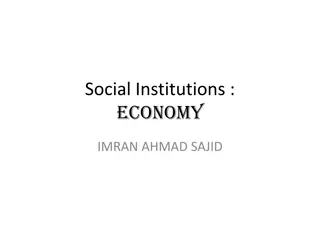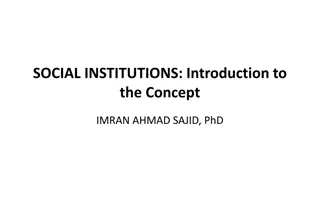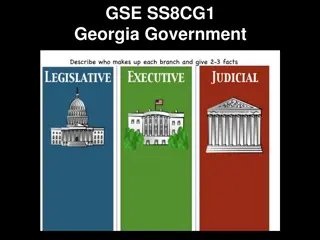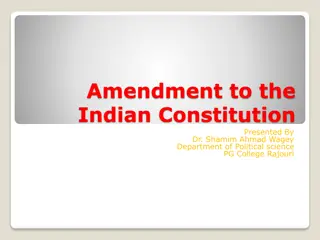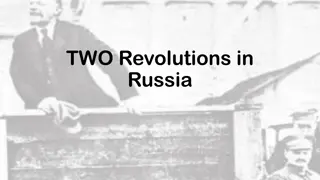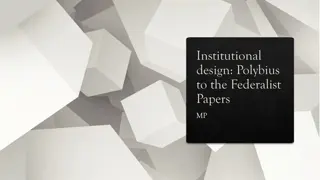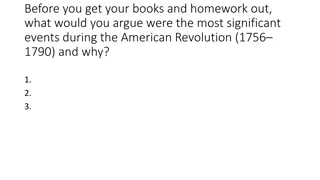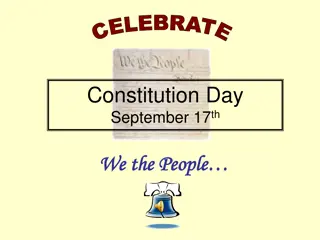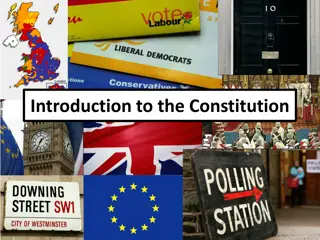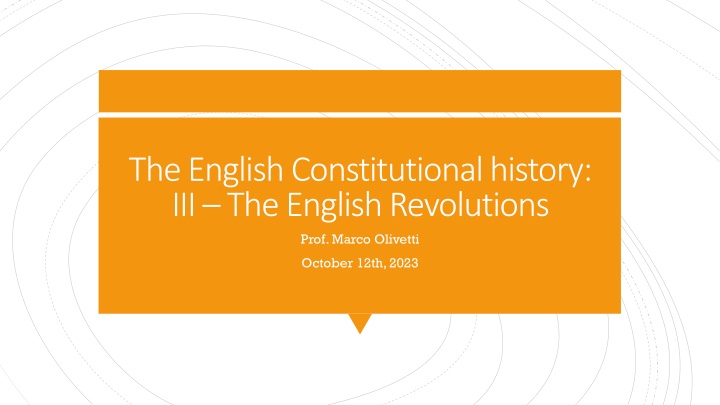
English Constitutional History: The Stuart Monarchs and Conflict with Parliament
Explore the English Constitutional history during the XVI and XVII centuries, focusing on the concentration of powers in the King, growth of bureaucracy, and the conflict between the Stuart monarchs and Parliament, particularly during the reign of James I. Understand the dynamics of the Divine Right of Kings and the limitations imposed on the monarchy by parliamentary statutes. Discover the financial tensions between the Crown and Parliament during this crucial period of English history.
Download Presentation

Please find below an Image/Link to download the presentation.
The content on the website is provided AS IS for your information and personal use only. It may not be sold, licensed, or shared on other websites without obtaining consent from the author. If you encounter any issues during the download, it is possible that the publisher has removed the file from their server.
You are allowed to download the files provided on this website for personal or commercial use, subject to the condition that they are used lawfully. All files are the property of their respective owners.
The content on the website is provided AS IS for your information and personal use only. It may not be sold, licensed, or shared on other websites without obtaining consent from the author.
E N D
Presentation Transcript
The English Constitutional history: III The English Revolutions Prof. Marco Olivetti October 12th, 2023
In all European States the XVI and the XVII centuries see a process of concentration of powers in the King and of growth of its bureaucracy Parliaments existing in those States during the Middle Age tend to disappear, or are marginalized: in France the Estates Generals are summoned in 1610 for the last time till 1789 Trends towards Absolutism In England the Tudor Monarchy (1485-1603) strengthened the position of the King but with Parliament and enlarged the functions of the State with the creation of a National Church, submitted to the King With the arrival of the Stuart dynasty on the English throne (James I, 1603) competition between King and Parliament becomes the main trend
House of Stuart James I 1603-1625 Charles I 1625-1649 (1640-1660 : I English revolution, then Interregnum) Charles II 1660-1685 The Stuart monarchs James II 1685-1688 (1688-89 : II English Revolution) Mary II 1689-1694 & William III 1689-1702 Anne 1702-1714 (From 1707 Act of Union Q. of Great Britain)
According to the theory of the Divine Right of the Kings, Kings were believed to God s lieutenants on earth and therefore they were believed to be enabled to rule in its name James I (1603-1625) wrote a treatise exposing this argument Yet, neither the Divine right, nor the position of the King as head of what today would be the Government and the central administration meant that they were considered to be absolute , therefore enabled to rule without limitations. James I and the divine rightof the Kings The King was supposed to be bound by the observation of the fundamental laws of the kingdom (a sort of un-written customary Constitution) In the English tradition, moreover, the King was obliged to rule not alone but with Parliament: parliamentary statute, adopted by the House of Commons, the House of Lords and the King was supposed to be superior to the King s act (ordinance). Taxation was supposed to be legitimate only with consent of Parliament. The medieval monarchy and the early modern monarchy (till XVI century) was a limited monarchy that had similar characters also in other European states
During the reign of James I, the king entered in a conflict with Parliament The question at the center of the conflict: the financial needs of the Crown. The extra-parliamentary revenues of the Crown were insufficient and the European wars had caused an increase in expenses Reluctance of the House of Commons to concede all the resources necessary for the Government s needs A second matter for conflict was religion: support of the King for the High Church and suspects of a Catholic restoration were criticized by supporters of Protestant reformation, specially in its Calvinist stream James I (1603- 1625) Accessory questions questions of parliamentary privilege: a) Freedom of access to the King by the Lords individually and by the Commons through their speaker b) Judgment on the MPs and freedom from arrest c) Freedom of speech (no member of Parliament should have been liable for words spoken in Parliament; Parliament should be free to discuss any matter the House thinks fit) James I s Parliaments (1603-1625): 1604-11; 1614; 1621 yet the conflict is still around the interpretation of the ambiguous parts of the constitution inherited from the middle ages and from the Tudor Era
During the Reign of Charles I, the conflict between King and Parliament escalated Country and Court, who were separated but not without possibilities for compromise and cooperation, gradually became divided. Three reasons - Charles I, first phase (1625-1640) the personality of the new King, unapproachable and uncommunicative - the financial question - the religious question: the support to arminianism (High Church) puts Charles in a condition of isolation within his Country (two problems: role of the bishops v. the lower clergy and the laity; doctrinal questions, mainly predestination) The English revolution was a constitutional struggle, a civil war and a religious war
In the first part of his reign (before revolution), Charles I summoned two Parliaments The first, in February 1626, lasted only some months and was dissolved for trying to impeach the most important minister of the King, Buckingham. Parliament granted only a small subsidy for the King. The second met in march 1627 and was more open to compromise as well as the King was: The parliament adopted a petition of right, that was accepted by the King, declaring unconstitutional some forms of extra-parliamentary taxation. Charles I and Parliament But differences arose on the interpretation of this prohibition, (some forms of taxation had not been mentioned in the Petition of Rights). Other controversies arose about religious question. The second Parliament of Charles I s reign was dissolved in 1629 For the following eleven years Charles I ruled without Parliament.
The relations between Court and Country were exacerbated The King managed to survive (a) withdrawing from the European wars and reducing expenses and (b) through extraparliamentary taxation. The outbreak of the Scottish Rebellion in 1637-1640 (also determined by the Charles religious policy) obliged again the King to organize the army and to fight a war and made the recourse to parliamentary taxation unavoidable. The eleven year tyranny (1629-1640) After 11 years, the financial situation obliged the King to call a new Parliament who met March 1640. In the so-called Short Parliament no compromise was possible and it was dissolved after two months. In the following months the situation got even worse at the border with Scotland, as the Scottish army entered in English territory during the summer, occupying Newcastle. Therefore the King was obliged to call a second Parliament in November 1640. At this moment, the ancient Constitution of England was on the point of breaking down
The constitutional struggle between King and Parliament (November 1640-December 1641) The King s attempted coup (Jan. 4th,1642) and Parliamentary reaction The phases of the first English Revolution (1640-1649) The first civil war (January 1644-1646) The failed negotiations between King and Parliament and radicalization of Parliament (1646-1648) The second civil war (1648) The radical revolution: army coup, Rump Parliament, trial and execution of the King (dec. 1648- January 30, 1649)
The constitutional phase of the Revolution Impeachment and execution of the main advisers of the King (Strafford and bishop Laud) Ensuring the Parliament s existence: obligation to call a Parliament every three years (Triennial Act, 1641) The Long Parliament: limiting the King s power (1640-41) Abolition of the Royal power of dissolution of Parliament the decision on the dissolution of Parliament may be adopted with the assent of the same Parliament Abolition of all extra-parliamentary taxation: taxes could be imposed only with the consent of Parliament Abolition of prerogative Courts (the Star Chamber and the Jurisdictions of the Councils of the North and of Wales) The problem of how to check the King s government in the future The question of the Church s reform
War in Scotland and Ireland Radicalization in Parliament and opposition to it Charles I s coup of Jan. 3rd, 1642: the attempted arrest of 5 MPs Petitioning movement Mitilia Ordinance : a Parliamentary army, implemented without the assent of the king break of the constitution by Parliament The Civil war: King versus Parliament The first Civil war 1642-46 Cromwell s New Model Army The battles of Naseby (14.6.1645) and Langport (10.7.1645) parliamentary armies defeat the King s armies The King sends the Prince of Wales in exile in France The search of a settlement and the further radicalization of the Parliamentary side (1645-49)
Episcopalians a Church based on the bishops, similar to the Catholic Church In the political field favor for the monarchy Presbyterians diminished role for Bishops and central place of priests The Independents Egalitarian and Puritan view of the Church parliamentary field Various forms of favor for a central position of Parliament in relation with the King Levellers equality, popular sovereignty transfer of the more radical ideas from the religious field in the political constitution Parliament vs Army
Failure of the negotiations between the King and Parliament lack of will to negotiate on the King s side; gradual radicalization and division on the parliamentary side Nineteen Propositions (June 1642) parliamentary control over the Church reform, over appointment of ministers, judges and governors, and parliamentary control of militia Oxford Propositions (February 1643) From direct to indirect (via financial power) control of ministers: the appointment of ministers and judges is left to the King (with the exception of some persons mentioned in the proposals), but the abolition of episcopacy is requested Negotiations and the failure of compromise Uxbridge Proposition (1644) further limitations to royal prerogative, including education of the King s children, to placed under parliamentary control Charles I s counterproposals restoring the situation existing in August 1641 Heads of proposals (1647): religious toleration, reform of the representative system through redistribution of the seats, a Council of State to assist the King in military affairs and foreign policy, parliamentary control of the militia for 10 years the idea of distinguishing permanent reforms from provisional measure against Charles I
Alliance of Charles I with the Scots Second civil war and new defeat of the King s armies (Nov. 1647-Nov. 1648) Purge (by the parliamentary Army) of the moderate wing of Parliament (dec. 1648): 110 MPs are expelled from the House of Commons and 260 withdraw The Rump Parliament The Rump Parliament Trial and condemnation of Charles II by the Rump Parliament Execution of the King (Jan 30th, 1649)
Abolition of monarchy and of the House of Lords after the execution of the King The Commonwealth of England (1649-1658) Cromwell as Lord Protector Lord Protector plus a Council of State and an appointed Parliament ( Assembly of Saints or Barebone s Parliament) The Interregnum (1649-1660) The Instrument of Government (1653), adopted by the Council of the Army The first Parliament (sept. 1654-Jan. 1655) Cromwell rules without Parliament (1655-1656) like a Stuart King, with the aid of Eleven Major-Generals The second Parliament (June 1656): offer of the throne to Cromwell, refused in 1657
The Humble petition and advice: the second written Constitution, approved by Parliament A bicameral Parliament, a weaker council of State, Cromwell as His Highness Cromwell s foreign policy: the Navigation Act, the war with the Netherlands and the rise of England to the status of Great power; the war of piracy with Spain in the Caribbean The Interregnum (1649-1660) The third Civil war in Ireland and Scotland (1649-1652): the slaughters at Drogheda and the root of the Irish rebellion against Britain Religious tolerance but only for puritan protestants, not for Catholics and presbyterian Anglicans
Cromwells death (sept. 1658) Richard Cromwell as the new Lord Protector (1658-9) A military coup against Richard Cromwell (1659) Recall of the Rump Parliament (42 MPs) and its dissolution by gen. Lambert The breakdown of the dictatorship George Monk, a general in Cromwell s army, marches from Scotland on England Monk calls a new elected Parliament (Convention Parliament, 1660)
Declaration of Breda by Charles II (4.4.1660): guarantee of freedom of conscience; large amnesty, with the exception of some crimes to be punished by Parliament Charles II King of England (29.5.1660) All the Acts adopted after March 1642 are repealed as being void because they had never received the royal assent The restoration: a compromise Repeal of the two acts of 1641 (Triennial Act and self- dissolution) Return to constitutional monarchy the King as head of government but with legislative and fiscal monopoly by Parliament
The period was one of ceaseless experiment with little positive achievement, but its inevitable end was a return to the tradition of rule according to law in place of the armed might which a score of tempestous years had raised to an intolerable predominance, and to monarchy as guardian of the law against the forces of anarchy and dissolution The years 1640-1660 Positive elements: new confidence to the House of Commons; its prevalence over the House of Lords; parliamentary control over taxation and legislation; a professional army; reorganization of the navy (D.L. Keir, p. 209)
What did the Restoration of King Charles II in 1660 in fact restore? a) Monarchy A Constitutional monarchy b) House of Commons c) House of Lords d) The Church of England
Convention Parliament, 1660 1661-1678 (Cavalier Parliament) a loyalist Parliament 1679 1679-1681 1681 Charles II (1660- 1685) Triennial Act The sitting and holding of Parliament shall not be intermitted or discontinued above three years violated after 1681 Religious policy: toleration towards Catholics and dissenters Foreign policy: alliance with Louis XIV s France, subsidies from the French government
The central fact: a Catholic King in a Protestant country James II appointed many officials of catholic religion Dispensation from the obligation to adhere to the Anglican religion as a condition for taking office (Declarations of Indulgence) James II (1685-88) and the Glorious revolution Alliance with France in foreign policy A first Rebellion: James Scott, duke of Manmouth (illegitimate son of the King) The birth of a male son (1688) William of Holland (husband of James s first protestant daughter Mary) lands in Britain James II leaves England A Convention parliament is called (1689) and declares that James II has abdicated
Few substantial innovations concerning the system of government Dualism of King and House of Commons Provisions to ensure the existence of Parliament a) The Bill of Rights, 1689 Parliaments must be held frequently b) Triennial Parliament, 1694: Parliaments will last no more than three years The new system of government c) Septennial act, 1715: Parliaments will last no more than seven years d) Royal power of Dissolution of Parliament before the end of its term e) In case of death of the King automatic dissolution (after 1696, continuation of Parliament, but dissolution after 6 months) The Act of Settlement, 1700 to regulate the future of the monarchy and to limit some royal powers
The power of suspending the laws or the execution of laws by regal authority without consent of Parliament is illegal Llevying money for or to the use of the Crown by pretence of prerogative, without grant of Parliament, for longer time, or in other manner than the same is or shall be granted, is illegal It is the right of the subjects to petition the king, and all commitments and prosecutions for such petitioning are illegal The Bill of Rights (1689) The raising or keeping a standing army within the kingdom in time of peace, unless it be with consent of Parliament, is against law The subjects which are Protestants may have arms for their defence suitable to their conditions and as allowed by law; Election of members of Parliament ought to be free
The freedom of speech and debates or proceedings in Parliament ought not to be impeached or questioned in any court or place out of Parliament Excessive bail ought not to be required, nor excessive fines imposed, nor cruel and unusual punishments inflicted Jurors ought to be duly impanelled and returned, and jurors which pass upon men in trials for high treason ought to be freeholders The Bill of Rights (1689) All grants and promises of fines and forfeitures of particular persons before conviction are illegal and void For redress of all grievances, and for the amending, strengthening and preserving of the laws, Parliaments ought to be held frequently.
In the case that both William III and Princess Ann die without heirs, the throne shall go to the heirs of Sophia, Electress of Hannover (a protestant granddaughter of James I) Every future Sovereign should be a member of the Church of England No foreign born King should engage in war in defense of his continental territories without the consent of the English Parliament The Act of Settlement He may not go abroad without the consent of Parliament No foreigner shall be allowed to sit in the Privy Council nor in Parliament The Judges shall not be removed from their offices by the Crown except on an address by both Houses of Parliament
The revolutionary settlement recognized the executive power to the King, who had to exercise it through its ministers The legislative power was placed in Parliament, composed by the House of Commons, the House of Lords and the King A constitutional dilemma The financial power (taxes and expenses), with a central role of the House of Commons How the right of the King to choose its ministers was to be reconciled with that of the House of Commons to refuse supply to ministers it did not trust ? (D. Marshall, p. 189)




